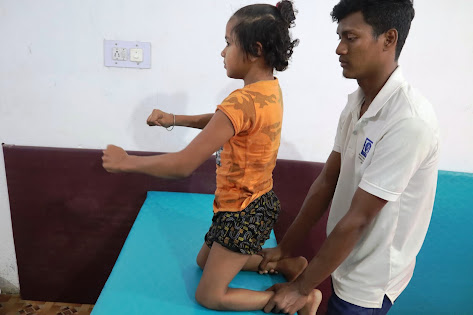SPASTIC CEREBRAL PALSY THERAPY PATTERNS
THERAPEUTIC INTERVENTION
FOR
"SPASTIC CEREBRAL PALSY"
1. Therapy Program for Spastic Cerebral Palsy
Stretching occupies a very important place while providing therapy in spastic cases. After performing appropriate stretching exercises, the small muscles are pulled back to their original position and stiffness around the joints is reduced. Hence proper stretching helps in reducing the deformity in the limbs and prepares the child to do self mobility activities.
2. What are the benefits of a daily stretching program
• This prevents the muscles from shortening.
• It reduces the stiffness around the joints and thereby increases mobility in the limbs.
• Reduces joint pain due to stiffness.
• This gradually improves the position of the body and prepares the child for proper mobility.
• This prepares the child to balance the body against gravity.
• It brings coordination to move objects around him and enhances self-care activities.
a. Stretching exercises for tight muscles of the thighs and legs
- Calf Muscles (Achilles Tendon) Stretching Exercises
- Hamstring Stretching Exercises
- Quadriceps (front thigh muscles) stretching exercise
- Adductor (inner thigh muscles) stretching exercise
- Gluteus muscle stretching exercise
b. Exercises for stiffness of the limbs and body
- Bilateral hip and knee exercises
- Hip rotation exercise
- Come to sit from supine position
- Kneeling
- Half Kneeling
- Chest raise in prone position
c. Bolster Therapy
- balancing with Bolster
- Squatting with bolster
- Supine to sitting on bolter
d. Ball Therapy
- Supine to sitting activity on ball
- Ball side rolling
- Trunk strengthening therapy with ball
f. Mat Activities Exercises
- Bridging
- Supine to sitting
- Kneeling
- Sitting to standing
g. Hand activities
- Open and close the bottle cap of different sizes
- Painting a picture
- Clay modelling
- Peg-board activities
- Hand clapping
h. Neuro-Developmental Therapy
- Teach baby to roll on tummy and back
- Teach baby to crawl with arms and legs
- Teach baby to sit
- Teach baby to kneel
- Teach baby to squat
- Teach baby to stand up from squatting
- Teach baby to walk with the help of a rollator
- Teach baby to walk independently
- Walking in parallel bar
i. Daily Living Training Activity Skills
- Teach oneself to feed
- To bathe
- To make enable for donning and doffing
- To make enable for sitting, standing and walking
- Enabling control of bladder and bowel functions








